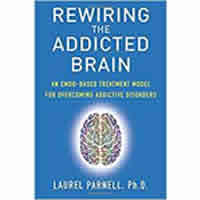 Written by Laurel Parnell, Ph.D.
Written by Laurel Parnell, Ph.D.
We all know that just telling people to stop their addiction won’t work. So, what should we then do?
In her latest publication, Rewiring the Addictive Brain, Dr. Laurel Parnell convincingly responds: combine EMDR to reprocess and clean things up and use resource tapping—a combination of positive imagery that activates positive resources internally and bilateral stimulation that serves to link this information together.
Eye Movement Desensitization and Reprocessing (EMDR) is a powerful therapy for handling trauma (small and big). EMDR re-establishes disrupted communication between the brain regions impacted by trauma. It functions with eye movements and/or other bilateral stimulation; it aims at processing information that is frozen and deactivated in the brain and body thus liberating people from negative beliefs and overwhelming emotions. The treatment involves a process focusing simultaneously on (i) spontaneous association of traumatic images, thoughts, mental and body emotions, and (ii) bilateral stimulation.
Bilateral stimulation is the use of alternating right left stimulation such as the case when one uses the resource tapping technique—using your hands you tap on the client’s knees, legs, arms or shoulders, simultaneously right, left, right, left (6 to 12 times, sometimes for longer periods). The use of tactile pulsars or headphones can also be used. This bilateral stimulation activates and integrates information from both brain hemispheres, which will strengthen and integrate resources so that they become easily accessible.
Parnell’s reasoning is based on Hebb’s rule: “Neurons that fire together, wire together”. When working with the brain, it’s useful to think in terms of memory networks—what is linked up and what is not. We want to find new patterns, new circuits to link up with the old ones so that the old ones are not going to be repeated. The question is thus: How am I going to either disrupt the old circuitry or create new ones?
Often clients know they should change outdated patterns, stop destructive behaviors but they persist. Why?
According to Parnell it’s simple: the part that is stuck in the addiction is not linked up with the part that knows what should be done.
Dr Parnell reminds us that to do EMDR the client has to be stable enough—both resourced and able to work within their window of tolerance. Stabilization is important because you surely want the client to be able to go through the process of revisiting traumatic events without becoming emotionally overwhelmed and without abreacting in an uncontrollable way.
To ensure stability, she suggests therapists use resource tapping to “light up” in one’s brain circuitry positive resources. Experience shows that by doing this form of bilateral stimulation it helps processing information and links new networks. So, if someone is feeling powerless, neurologically speaking, he is activating and lighting up an “I am powerless” circuit. To counter this activation, we then activate times when the client felt powerful and we light those up and add bilateral stimulation and the client changes without even having to do the trauma work to get resolution of the symptoms. Why? Because we are linking new neural networks that are positive.
Parnell also reminds us that EMDR is fine with processing trauma but what do we do with “the absence of” kind of situation? The absence of never having a secure attachment, for example. This is where the use of imagination and bilateral stimulation can fill in the gaps and provide new circuitry for that which is missing inside.
In her book, Dr. Parnell provides us with an amazingly rich toolkit of resources that can be used to rewire the nervous system and broaden the clients’ sense of themselves and their capacities. She emphasizes that positive resources like compassion, the capacity to love, and the ability to be grateful are dormant in everyone that need to be activated and “tapped in”.
The book is thus all about resourcing and to me is an extremely useful tool for practitioners. For example, the “Connecting the Consequences Protocol”. In summary: assume a client is addicted to cocaine. The sequence is: the urge to acquire the drug, the waiting until the taking, the taking, the staying up all night with the high and the horrific after effects of fear, terror, self-hate, shame and physical depletion for days. Dr Parnell investigated this scenario, asking how someone could do this to themselves? She found out that people do this because the highs are not connected to the consequences. So, by playing the movie of the complete sequence in his mind from the beginning of the urge to use, the use, the high and the consequences, paying special attention to emotions and body sensations, the linkups were created, and the urge vanished.
This process is brilliant and elegant and already now proven to be super-efficient. In my opinion, this is a book worth reading and to be used as a valuable working tool for therapists.
Reviewed by Geric Lebedoff, Licensed Psychotherapist







